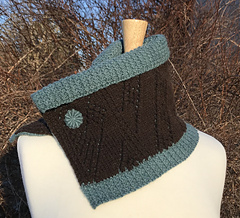patterns >  Kokoro Patterns
Kokoro Patterns
> Covered Bridge







Covered Bridge
Michigan has more than 50,000 miles of river and has been inhabited for centuries. It is home to many beautiful bridges built long before modern materials and power tools existed. These elegant and practical structures were constructed from hand-cut lumber and hand-forged nails.
Covered bridges were once common across Michigan. They required even more material and were more challenging to build than an open bridge, but the roof significantly extended the bridge’s lifespan by protecting the wooden structure from sun and weather damage. Although most open wooded bridges survived fifteen years at most, about a dozen of Michigan’s covered bridges remain in service today, more than a hundred years after they were first built.
Our Covered Bridge is a double-layered, buttoned cowl inspired by the historic covered bridges of Michigan. The second layer is picked up from and later joined to the first, like a roof built over a bridge. The lace motif is reminiscent of the timber-truss lattice of many wooden bridges, with the river-colored second layer peeking through. The fold-over ribbing nods to a roof covering, and the optional covered button is acknowledges the craftsmanship that went into these charming structures. Even the yarns are pure Michigan: Why Knot Fibers’ Smitten is made of wool and alpaca fibers raised, spun, and hand dyed in Michigan, and Iron Wheel Farms’ Finn Sport is raised and spun in Michigan (and left undyed in its glorious natural state).
Yarn: 1 skein each Why Knot Fibers’ Smitten DK in Ripple and Iron Wheel Farms’ Finn Sport in Natural.
Sizes: Covered Bridge is written for two circumferences, small (22 inches flat, 19 inches buttoned) and large (24 inches flat, 21 inches buttoned).
Modifications: The cowl is built on a 14-stitch repeat, so it can easily be widened or narrowed. The ribbed hems also could be lengthened or shortened to adjust the depth of the cowl.
Notions: Tapestry needle, stitch markers, scrap yarn or other means of holding live stitches in reserve.
Notions for Optional Button: One flat 1-inch button, a 2-by-2 inch scrap of cardstock, scissors.
Instructions: This pattern includes charted and written-out instructions. It additionally includes complete instructions for making a covered button for your cowl.
Thanks: To Sharona (called Ducky).
9 projects
stashed
5 times
32 projects
stashed
51 times
- First published: May 2018
- Page created: May 17, 2018
- Last updated: October 15, 2020 …
- visits in the last 24 hours
- visitors right now




